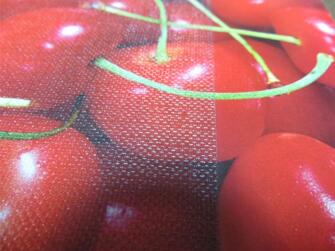Advantages and disadvantages of laminated canvas
Canvas prints have become a widely adopted method of showcasing precious artwork, photos and memorabilia, adding a vibrant, textured aesthetic to any space. The question that often arises is: is it safe to laminate your canvas prints? In this detailed guide, we'll look at the pros and cons of canvas lamination, to help you decide if it's right for you.

Understanding canvas lamination Canvas lamination involves applying a thin transparent plastic film to the surface of a canvas print, forming a protective shield against various forms of damage: Scratches and abrasions: Protects the delicate surface of the canvas from accidental marks and scratches. Moisture: Repels water, dirt and dust, making it suitable for high-traffic or damp environments. Fading and UV damage: Slows the fading process caused by direct sunlight and fluorescent lighting. To laminate or not to laminate Here's a concise overview of the advantages and disadvantages of each option:
Lamination :
Greater durability against physical damage, moisture and fading. Easier to clean: simply wipe away spills and dust. Enhanced shine, as laminate can intensify colours. Disadvantages: Alters texture and appearance by adding a slight sheen and reducing the natural texture of the canvas. Risk of air bubbles if applied incorrectly. Irreversible process that increases the overall cost of printing.
Non-laminage :
Advantages : 1. Preserves the original texture and appearance, retaining the natural look and feel of the canvas. 2. More cost-effective than laminated prints. 3. Reversible, without permanently altering the artwork. Disadvantages : 1. Less durable and more susceptible to scratching, tearing and fading. 2. Cleaning must be carried out with care, as water can damage the ink and canvas. 3. Less suitable for high-traffic areas prone to dirt and moisture.
Laminating art prints
Laminating canvas is particularly beneficial for : 1. High-value works of art, which benefit from increased protection. 2. Works that are frequently handled, such as children's art or those exhibited in high-traffic areas. 3. Works of art displayed in high-traffic areas such as kitchens, bathrooms or commercial spaces.
Is it worth laminating the canvas?
Ultimately, the decision to laminate your canvas prints depends on individual needs and preferences. Factors to consider include the value of the print, the intended location, the desired look and the budget.
Additional advice
1. Opt for a high-quality laminate, choosing scratch-resistant and UV-resistant options for optimum durability. 2. Choose a reputable printing service that uses professional lamination techniques to avoid air bubbles and imperfections. 3. Explore other protective options, such as acrylic frames or canvas varnish, which offer similar protection without altering the texture.
Conclusion
Thanks to this comprehensive guide, you now have the knowledge you need to make an informed decision about canvas lamination. Whether laminated or not, your most expensive canvas prints can be preserved in the best possible way for years to come. Keywords: laminated canvas, canvas lamination, canvas print lamination, canvas lamination, canvas protection, laminated prints, art print lamination, canvas coating, print lamination, where to get a canvas laminated, canvas images, laminated images. If you have any other questions, please don't hesitate to ask. I hope this article answers all your questions.
Comments